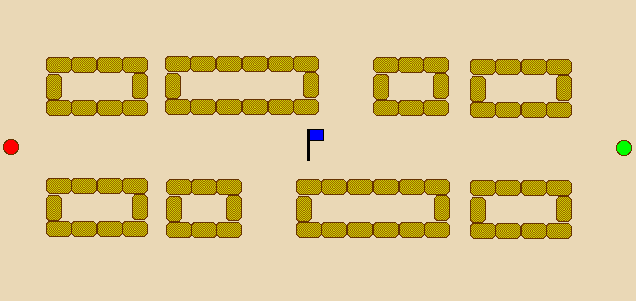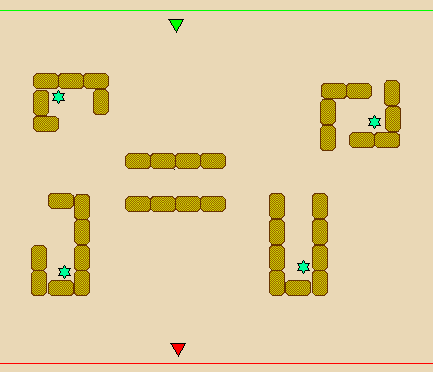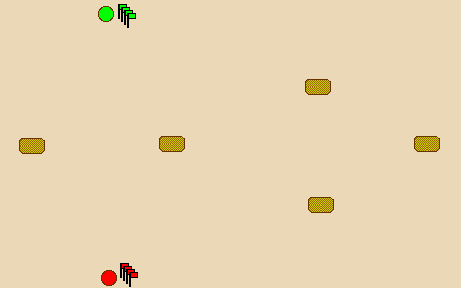The lengthy ride back from day-tripping Assessment was made no more bearable by Wistric’s company. Such are the perils of carpooling. As we cruised through rural NC, the subject of unusual scenarios came up, and the discussion was deep enough to keep us occupied ’til home. Most melee scenarios (or tournaments, for that matter) follow a standard pattern, a handful of parameters in familiar configurations—town battle or field battle? Rez or no rez? How many flags? DFB? Alright, let’s fight.
But a number of truly memorable melees have come about when the rules change substantially. Armored-as-worn, zombie fights, or unusual terrain force commanders and fighters alike to think on their feet, adapting and innovating on the boilerplate tactics we all know. That’s at the heart of fencing, game theory, and warfare at large: outthinking the other guy, knowing he’s trying to do the same to you. Reacting to dynamic problems. Making the most of what you have.
I’ve a fairly extensive tabletop wargaming background, where screwball scenarios quickly become necessary to keep the game fresh and fun after tactics and armies have been optimized by experience, and it strikes me as a little strange that we don’t see more of these scenarios. Perhaps it’s because RMICs are risk-averse and prefer to stick to the tried-and-true. Perhaps they don’t wish to place additional logistical demands on their subordinate marshals, the autocrat, or the MOLs. Perhaps they’re just not very creative.
In the car, Wistric challenged me to devise a few scenarios that were out of the ordinary. I spouted off a few, and we got to discussing some interesting ideas. Here are three I came up with awhile back. Rather than take the sky’s-the-limit approach, I have endeavored to minimize the number of moving parts, adding enough spice to be engaging without burying new fencers under a mountain of special rules, or overwhelming RMIC’s with logistical nightmares. Comment, contribute, and do your best to break them. If there’s interest, I’ll try to post a few new ideas periodically and inspire a little creativity among Atlantia’s rapier population.
Payload
Objective: move the flag past the goal line (or have the flag past the halfway point at the end of the round).

Setup: Each team has a single rez point. The field is divided into three lanes by uncrossable obstacles. (Hay bales serve in the example above, with internal spaces to allow dead fencers to remove themselves from combat easily, but lengths of list fence could also work.) The specifics are up to the MIC; the diagram above is just an example. There ought to be numerous opportunities for flanking via narrow alleys.
Suggested Numbers: 10-20 per team
DFB: yes
Resurrections: Unlimited
Time: 3-5 mins
Variations:
- Each team has a flag. Team with their flag closest to the enemy rez point at the end wins.
Three flags are placed down the center. Team with the flag closest to enemy rez point wins.
Two lanes rather than three (for smaller teams)
Logistical Considerations: this one is pretty easy to explain and set up. It does require a fair amount of space. The scenario translates well to a woods battle, where the terrain often naturally mimics the setup and limited visibility adds another layer to the strategy.
Commentary: town battles provide some very interesting terrain and flanking opportunities but too often devolve into a static limited-front engagement along a string of bottlenecks. The idea here is to force teams to spread out and make it increasingly difficult for an advancing team to adequately cover its flanks. The higher the number of fighters, the wider (or more numerous) lanes must be to keep the fighting dynamic.
The Choir Invisible
Objective: last team standing wins.

Setup: The field contains a number of buildings or other terrain elements. Some contain a relic. Each team has two Priests, selected and clearly marked before the round begins, and a stationary altar.
Relics: only Priests may carry relics. Carrying a relic precludes the use of an offhand (although depending on their nature, relics may provide rigid or floppy parry). Once picked up, relics must be taken directly to the team’s altar; they may not be stockpiled or held for extended periods.
Rezzing: fighters do not rez, but rather stand behind the rez line when killed. If a Priest returns a relic to the team’s altar, a line marshal yells something uplifting, and all the team’s dead rez immediately.
Suggested Numbers: 8+ per team
DFB: optional
Resurrections: restricted; see above.
Time: to victory conditions
Variations:
- Priests must move at an appropriately stately pace (a walk) while carrying relics
Relics are immobile, but may be redeemed on the spot by a Priest (he will have to communicate his intent somehow to the line marshal)
Run as a woods battle, perhaps with distinctive relics in undisclosed locations
Instead of being drawn from the team’s ranks, Priests are disarmed, armored marshals who move as directed by the team’s commander
Logistical Considerations: the Priests must follow additional rules, but these are easily within the cognitive means of journeyman fencers to remember in the heat of battle—newly scarfed fighters will have little to worry about apart from the melee. Pretty much anything can be designated a relic (bits of PVC pipe, wooden blocks, a scarf, etc), so the material requirements shouldn’t be too difficult to meet.
Commentary: for fighters, this scenario blends the defensive game encouraged by limited- or no-rez scenarios with the faster pace and higher fight-time offered by rez battles. Securing a rez becomes more risky but more valuable the more fighters you lose. The scenario encourages a game of brinksmanship among the commanders; each wants to hold out just a little longer than his opponent before going for a relic. The limited number of Priests add another dynamic, as at least one Priest must be kept safe to ensure rezzing. The number and location of the relics can change strategic considerations immensely.
Territorial Control
Objective: at the end of the round, control the most hay bales.

Setup: Each team is given 30 small stake flags of their team color; they will use these flags to claim the hay bales. The flags are held at rez point. At the end of the round, a team controls a hay bale if they have more stake flags in it than the opposition. Should each team control the same number of hay bales, the team with the most total flags planted is declared the winner.
Flags: fencers may carry one stake flag at a time. These preclude the use of an offhand weapon and are dropped on death. Fencers may not touch opponents’ flags.
Suggested Numbers: 4+. Adjust time and number of flags/hay bales as necessary.
DFB: yes
Resurrections: Unlimited
Time: 3-4 mins
Variations:
- Teams must designate 2-3 flag-runners each; only these fencers may plant flags
Can be run as a woods battle, particularly with the limited flag runners variant described above
Assign point values to each hay bale, weighting them differently
Logistical Considerations: aside from the material requirements of stake flags (which are pretty cheap), this scenario is easy to understand and easy to run. Hay bales can be replaced by just about anything that will hold a flag.
Commentary: we ran this scenario at Thursday practice. Five fencers to a team, with 20 flags, on a three-minute timer worked out perfectly. The off-center layout and option to continually one-up the opponent lent itself to some interesting strategizing; also, with such small numbers, nearly everyone was a flag-runner—which meant nearly everyone was carrying a single blade and there was a lot of skirmishing. This gave the less experienced fencers (who only carry a single blade anyway and aren’t too well-versed in line fighting) a chance to run around, be useful, and score kills. It seemed to work well and the feedback I received was positive.
One stumbling point, however: the wire on the stake flags we used was thin enough to fit through a standard fencing mask’s mesh. I suppose you could fold the end over itself with pliers, but that might weaken the wire and make it difficult to plant the flag. If running this scenario at an event, it’d be best to construct more substantial flags or slightly rework the mechanics of the scenario.
Pingback: Wistric
Pingback: Ruairc
Pingback: Dante di Pietro
Pingback: Alric
Pingback: Dante di Pietro
Pingback: Wistric
Pingback: Ruairc
Pingback: Alric
Pingback: Ruairc
Pingback: Wistric
Pingback: Ruairc
Pingback: Alric
Pingback: Wistric
Pingback: Miriam d'Hawke
Pingback: Alric
Pingback: Ruairc